Published by Jeremy. Last Updated on September 19, 2023.
Disclaimers: Our site uses demographic data, email opt-ins, display advertising, and affiliate links. Please check out our Terms and Conditions for more information. Listed prices and attraction details may have changed since our visit and initial publication.
If you’ve ever visited Istanbul, you’ll no doubt have seen hundreds upon hundreds of the gorgeous and ornate Turkish lamps that are found throughout the city. Our first thought was that these lamps were pretty awesome, and without hesitating we began a quest to to buy one for our (at the time) future home.
This was all well and good, but there was one problem: we had no idea how to make it work when we got home.
Luckily for us, modifying the lamp turned out to be incredibly easy, and you don’t have to be an engineer with an electrician for a father to figure it all out (that being said, I’ll give you one guess which category we fell into).
But if you have reservations about making your Turkish lamp working at home, this step-by-step guide is all you need to take your boxed up lamp and turn it into the star attraction of a room!
✈️ Book Your Next Trip
- • Planning a trip? Find a flight deal.
- • In need of a room? Check out hotel and apartment prices.
- • Taking a cruise? Find a cruise itinerary for your journey.
- • Don't overlook picking up a rental car or day tours as well!
Step 1 – The Bulb Sockets Aren’t the Same
The main problem with European lamps as compared to American lamps is that the socket sizes are not the same. Our Turkish lantern uses European E14 candelabra bulbs with a socket of 14 mm width. American candelabra bulbs on the other hand are only 12mm wide (known as E12).
When we first screwed a bulb in and turned it on we didn’t know this. The bulb went too far down into the socket and short circuited. The bulb burnt out, there was a spark, and we melted a piece of metal on the inside of the socket.
Oops – not a good first test. (I said I was an engineer, I never said I was skilled in electricity.)
After realizing our mistake and performing a quick search online, we found candelabra adapters to reduce E14 sockets to E12 for just $1.50 each. Apparently we were not the first people with this problem and the internet saved us on our first step. We bought a ten pack on Amazon (get yours here) and were off and running.
Step 2 – Don’t Go for High Wattage Bulbs
Now that you can get your bulbs screwed in, the next step is to ensure you use the right bulbs and don’t burn your house down. No pressure.
This is pretty crucial as high wattage bulbs will risk overloading the amperage draw on the wires. Doing so may cause the wires to overheat and possibly catch fire. But as it turns out, this is pretty easy to avoid.
The equation that dictates how much amperage you’ll draw is Ohm’s Law. It is simply this:
Amps = Power (Watts) / Voltage
Take the power of the bulb in Watts, divide it by the Voltage (for American houses it is 120 V), and you’ll get the amperage draw in one light socket in your lamp. Add it up for all the bulbs in your lamp to get the total draw across the common wire and that is all you need.
After calculating this number, you’ll then want to compare it to the amperage rating of the wire base on its gauge size, and ensure you are nowhere near that maximum capacity (I’ve read that 80% is a safe figure, but for a home made customization it is good to be as low as possible).
Unfortunately for Turkish lamps like ours, there are seven bulbs which connect into a single cable, so you have two issues to consider.
- The amperage in each individual line.
- The amperage drawn on the combined line going into the wall.
Assuming both wires are the same gauge size, your amperage draw will be limited based on the cumulative total from all the bulbs. As ours had seven, we had to look at the calculation like this:
Amps = Power / Voltage * 7
Using 4W candelabra bulbs, we were pulling 0.23 Amps across the main wire, and 0.03 Amps across the individual wires leading down to the bulbs themselves. With an overall rating estimate of about 7-10 Amps for the wire (based on estimated gauge size), we’re nowhere near capacity. But if you put in 120W bulbs, you can see that you’re getting close.
Overall, with the number of modifications you’re making past the factory designed settings, it is probably a good idea to be as far away from the rated figure as you can. Luckily 4W bulbs look great, and since you’re not using the lamp to light a room you should be fine. (Although with any home modification that hooks up to electricity, you probably don’t want to run it when you’re not there either way).
Note – If your lamp has any electronics attached to it like a dimmer you may have to make more modifications as those may not play well with US voltages.
Step 3 – Alter the Cord Length and Hang
When it comes to hanging a Turkish lamp, we’re not experts. We got very lucky in that the maintenance team for the house we are renting was able to hang it for us without issue. Our seven bulb lamp did not require any special insets into the wall as there was a rather robust wood beam for it to screw into in the exact spot we wanted to hang it.
Past here, for significantly heavier lamps or odd placements, you may want to look into a chandelier brace and other additions to your ceiling depending on the type of construction of your house.
Other than physically hanging the lamp, which we hope will be an easy task for your situation, you will likely have to extend the wire leading to the nearest electrical outlet.
For us this meant buying a few items from our local hardware store:
- 18 gauge electrical wire (gauge should match the lamp’s specific wiring).
- Wire nuts.
- Electrical tape (although we decided not to use it).
- A wire-to-wall plug.
- Wire conduit or other adhesive to affix the cord into place.
This task is pretty simple as you have to strip the wire, connect the extension to the corresponding wires, and use the wire nuts and wall plug to lock it all in place.
As there are numerous guides out there on the internet on how to do this, we’re not going to reinvent the wheel here. Our only recommendation would be to get a wall plug with a big enough opening for the electrical wire, as many exist with smaller openings that larger gauge wires do not fit into (not that this happened to us or anything…).
After that you are good to go and a new, and awesome, Turkish lamp will be yours to enjoy!
Items You May Need to Install Turkish Lamps
This post referenced several items that we purchased in order to hang our lamp (plus a few others we did not end up needing). They include the following:
- Low Wattage Chandelier Bulbs Size E12 (One Per Bulb)
- E14 to E12 European to American Chandelier Converter (One Per Bulb)
- Digital Multimeter
- Extension wire to run to an outlet (be sure to select the proper gauge size and color to match your lamp)
- Wire Strippers
- Electrical Plug
- Wire Nuts, Wire Conduit, and Electrical Tape
- Chandelier Brace (If needed to hang)
What about those who haven’t been to Turkey to buy a lamp? Don’t worry, Amazon sells some pretty cool ones too if you want to buy a lamp and have it shipped directly to your house! Click here to check them out. (Note: Modifications as outlined in this post may be necessary).
Read More Lifestyle Design Articles
About Jeremy

About the Author: Jeremy is a full-time travel writer based in Pittsburgh and primary author of this site. He has been to 70+ countries on five continents and seeks out new food, adventure activities, and off-the-beaten-path experiences wherever he travels.
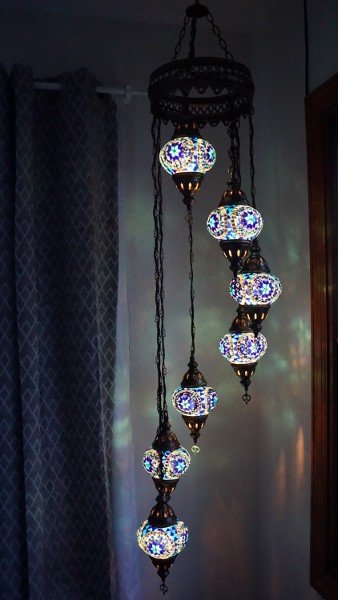
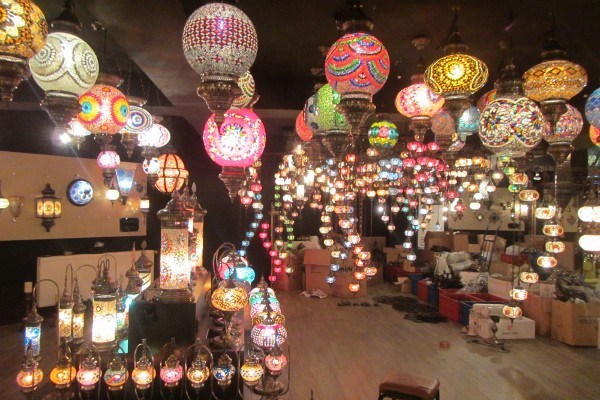
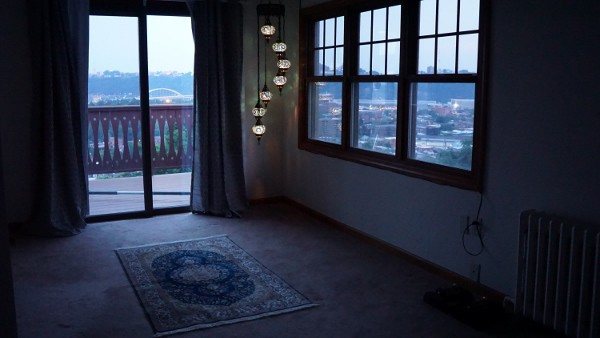
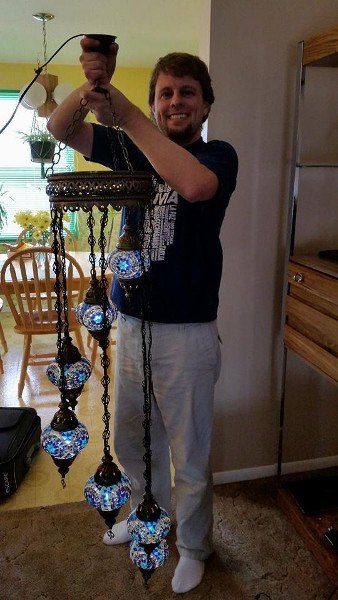
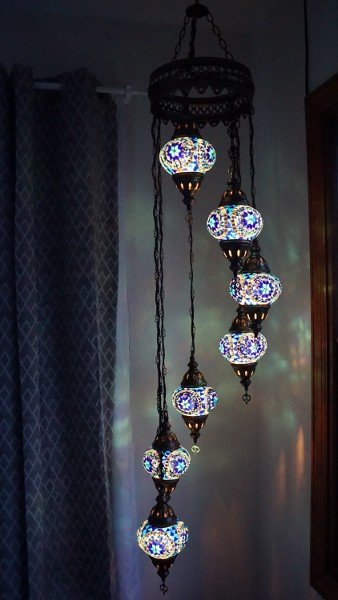
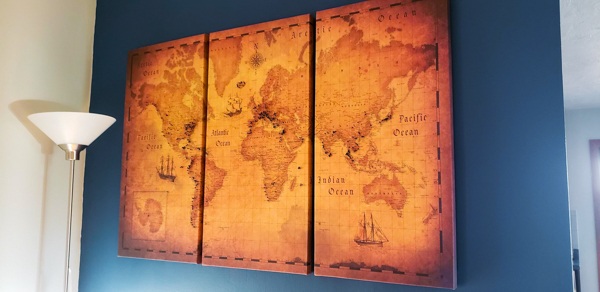
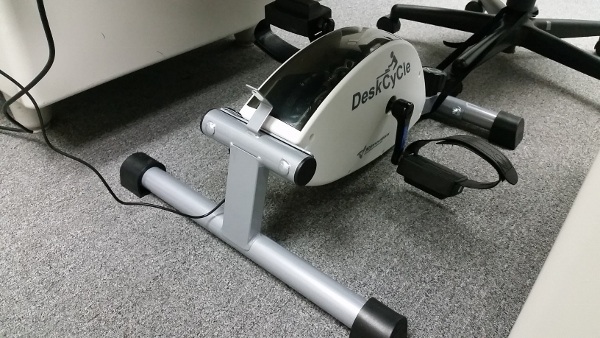

I purchase a lamp in Turkey, but it did not come with a plug, it came with two wires together. I remember seeing these wires wired to a square device that was plugged. Does anyone know what this device is called?
It is called an electrical connector, Google it for the image for better understanding
Great article. I found this after unknowingly putting E12 bulbs in the E14 sockets and having a socket arc with flames and sparks. My wife ordered the reducers, but I ultimately decided to replace the E14 sockets with E12 sockets. It took about an hour to replace all 17 sockets on our Turkish lamp and it now works like a charm (no fire or sparks…so far). Thanks for the amazing write up!!
Thanks so much. I’m glad to hear we could help. Hope you’re enjoying your lamp as much as we like ours! We’re eight years in now and no issues for us.
Thanks for the great article! I’m hanging my lamps in an area without an outlet, so I’m sticking a couple of remote-controlled mini-LED light pucks in there and see how it goes! My next quest is to find a bracket that will go well with it :).
I’ll be curious to hear what you think of this one!
Is there a reason that you would get the converter over just getting the right bulb? Do you know what the bulb size would be? I’ve already made a few returns from getting bulbs that don’t fit….
I can only speak to what my lamp was, which we purchased in Istanbul. They generally use E14 shaped bulbs and in the US we use E12. The number is the width of the socket in millimeters, so the socket was just a bit bigger than standard US bulbs. I purchased the adapter because I didn’t want to have to seek out European bulbs over time. I’d have to imagine if you can find them they’d work just fine but would still consider finding low wattage options.
Thank you for the walkthrough and links. This is great.
Hello!
I got one Turkish lamp and I live in Japan. Here is 110V and now I figured out that I forgot the lamp For the chandelier and I don’t know which one should I get. Do you think that is it E14 or E12? I appreciate your help. Thank you.
It is hard to say without measuring or testing one bulb over another. If you bought it in Turkey or its made in Turkey, then it is probably E14. But if you bought it overseas it may be customized for the market.
Thank you so much for writing this up! I got a few lamps from Istanbul and was clueless about what to do until I saw your post. I’m bookmarking this page!!!
This is a great post thank you for putting it online as others have said I’m having a hard time finding any information about this lamp I ordered from Turkey. I like the idea of buying converters and I definitely bought some just in case. However the biggest problem that I’m having is I am not sure if my wire lamp is already wired for the United States because the seller only stated that it was us “plug and socket” would it make sense to buy both e14 and E12 and see which one is more effective or does that risk burning out the lamp? It shouldn’t matter if they’re both very low wattage right?
The difference between E14 and E12 should just be the thread size. I don’t think you’d be at risk of burning out the lamp as one would not screw in correctly while the other would. I would guess the socket size is standard to Turkey but if you bought it customized specifically for the US market I could see the bulb size being different.
Jeremy,
Just received our Turkish lamp from Amazon. Couple questions: 1) I picked up some Ryet LED 200 lm bulbs at Ikea – there are a bunch of numbers on the packaging:
120V~60Hz
CRT>82
100 lm / W
2W
I’m assuming that means 2 watts?
2) I’ve got the first later on with the spring mechanism – it looks beautiful. And then I’m like how the heck do I get it back off when I need to change th build. Probably a silly question – but I’m clueless and I don’t want to break the glass.
Thank you,
–Kathy
Hi Kathy! Yes the 2W should mean 2 watts which should be fine for your lamp. With regards to the spring mechanism, if your lamp is like ours the spring holds two large metal pieces into place that stick out from the fitting (one on each side). If you had to squeeze the metal pieces together to assemble the lamp, then all you have to do is likely give a solid pull and it’ll come right out. They just hold it together via tension as the spring pushes them outward, but they’re designed just to slip off with a pull. But, as I mentioned, I can only speak for what my design is. I suspect they’re all similar though!
Thank you soooo much for this article! It’s the only one out there and so helpful with detailed info! Can’t thank you enough!
Happy to help. Would love to see a photo of your lamp when you get it finished!
Hello Jeremy
Just wanted to thank you for all the useful information u provided … it all worked out .. only thing i had to buy was the e12/e14 converters …
That’s awesome. Great to hear it worked!
Might I ask how do you bring those lamps (chandelier) home? It looks big and its not like a small single lamp.
We had to buy a second carry-on sized suitcase in the market in order to pack them all in. Oddly enough we were able to fit two lamps into the suitcase though (one for us and one for a friend)!
If I only have one lamp would a 4 watt bulb still be the best/safest to get?
I think the lower wattage you can go, the safest you will be. But 4 watt for a one bulb lamp should be okay. I would still not leave it on for extended periods of time just because you never know how it was wired if it was more hand made.
Um silly question how did you remove the decorate light bulb coverings – were they glued and you reglued them? Also ours has lightbulbs in it supplied by the guy in Turkey – will they just blow out and we need to change them? thanks!
Hi Amber- ours were not glued and come out with a spring mechanism. I would probably replace the bulbs unless you know what they were rated for (if printed on the bulb, for example).
Hi,
I just bought a Turkish crystal chandelier. It has regular sockets like ours e26 or e27 (euro). I’m setting power to the socket the bulbs just won’t light. Do I need a special type? My wife insist that if Turkey uses 220 then I have to change the wiring but it doesn’t make sense to me. The light was made in the 60’s.
Thanks
Pat
Hi Pat,
I’m not an electrical expert by any means, but I can’t imagine that the wiring would require changing. As long as you have low wattage bulbs and the adapters for the lights I feel like you should be okay. That is all we really needed for ours but we bought ours in 2013. Is it possible the line is disconnected somewhere? Have you checked with a multimeter to see if you’re receiving power?
Hi Ive just bought a turkish lamp, a heavy one! It came with no screws or plate to fix it to the ceiling. How do i actually attach it to the ceiling please? Thanks. Louise
Hi Louise. Unfortunately that was the only step we had to outsource to someone else as our landlord took care of that. I believe they found a beam going across the ceiling to hold it, but from there I cannot say for sure what they used.
Hi Louise have you had any luck with this? Mine has just arrived and I have the same problem!
Hi my lamps main dual connection wires are both black with no colour coding, so how can i connect it to existing ceiling wires correctly?
Hmm. I’m not an electrical expert unfortunately so I cannot say with certainty. Have you tried the various combinations of setups with a multimeter to see what comes out? I suspect there has to be a few good guides out there that help solve this issue too.
Hi, did you ever solve this problem? I have the same and don’t know how to wire my lamp
Hello I know this is an older post but I bought a Turkish floor lamp and I am wondering which bulbs for e 12 to buy? There are different shapes and I wasn’t sure
Which were correct. Thank you
In advance.
Hi Tara, it would be hard for me to say because you need to check the size of the lamp housing area itself because bulbs that are too long may not fit within the decorative cover. My understanding, and experience with our hanging lamp, is that as long as you have a reducer from E14 to E12 (if bought in Europe) then standard US candelabra bulbs will work unless they are too long and hit the end of the lamp covers.
I still would recommend something on the low watt range just to be safe though.